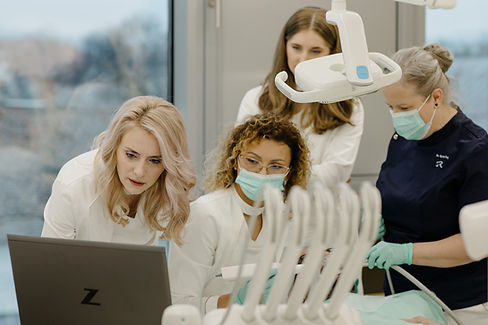The treatments for oral rehabilitation and prosthetics
Oral health is an integral part of our overall health and should be a priority, yet it is often left unresolved or postponed, leading to extensive dental wear and even tooth loss.

Oral rehabilitation is the process aimed at restoring the integrity and functionality of the dento-maxillary apparatus (teeth, periodontium, bones, muscles, temporomandibular joint), which may be altered by various inherited or acquired conditions.
Dr. Medeea Tălmăceanu, Dr. Daniel Tălmăceanu, Dr. Sandra Gorcea, Dr. Anca But, Dr. Vlad Băncescu, and Dr. Raul Ghiurca form our team that performs complex oral rehabilitations. These specialists, like our entire team, share a working philosophy that prioritizes quality and planning time in every treatment. They are the ones who often have a comprehensive vision of cases involving various dentistry specialties, working with a common goal: restoring harmony in the oral cavity, both functionally and aesthetically, with long-lasting results.

The process begins with the accurate diagnosis of the changes present in all components of this dento-maxillary complex, from the temporomandibular joint and muscles to the enamel or gingival texture, assessing the health status of the maxillary and alveolar bones, periodontal support, dental pulp, hard dental structures, and occlusion (bite). All these components, similar to any mechanical complex, are closely interrelated. Addressing unilaterally some of these components, without having the perspective of the whole, can be useful but is often insufficient.
The investigation of conditions affecting the dento-maxillary complex is conducted through both clinical examinations and the use of modern technologies (intraoral 3D scanning, volumetric tomographies, computerized recordings of joint movements, 3D simulations of aesthetics and proportions), aiming to identify all changes resulting from inherited or acquired conditions (tooth loss, changes in their position, dental wear, etc.).

Oral rehabilitation is a complex process involving all subspecialties of dentistry, both in the investigation phase and in the treatment phase. It is a multidisciplinary effort through which the patient regains the functionality of their teeth, chewing ability, as well as aesthetic function, the smile, with stable results over time. Modern dentistry increasingly incorporates this process of oral rehabilitation due to the broad perspective it entails, but especially because of the long-term stable results generated by achieving aesthetic and functional balance among all components of the dento-maxillary apparatus.

The future of modern dentistry is represented by conservative dentistry, whose primary goal is to preserve as much as possible of the patient's biological structures (enamel, dentin, bone, soft tissue). Minimally invasive treatments are an integral part of this approach. Supported by technological advancements and materials science, minimally invasive treatments have been clinically and scientifically validated in recent years, becoming widely adopted in current practice. Minimally invasive techniques are implemented only for incipient lesions, using modern technologies such as optical microscopy, therapeutic lasers, and digital planning, which allow for high precision, useful in differentiating and preserving healthy tissue. All dental subspecialties have incorporated computerized and minimally invasive techniques, providing patients with both comfort and faster recovery following treatment. They are also available in our clinic.







